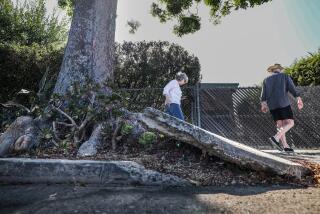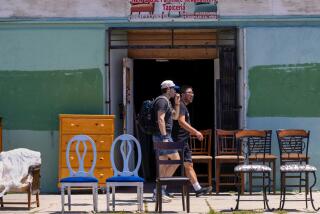Mapping the danger of L.A. streets
Western Avenue is one of the longest streets in this sprawling city and one of the most eclectic, running from the wealthy enclaves of Palos Verdes through Inglewood, Koreatown, Little Armenia and up into Hollywood.
It is also one of the most dangerous for pedestrians,
Over 2004 and 2005, at least 10 pedestrians were killed in accidents on Western, we now know thanks to some great new technology and the federal government finally releasing some secret data. The information might also tell us something new about the hazards of crossing streets in Los Angeles and ultimately driving in general.
Earlier this year, I wrote about a battle a private Maryland safety researcher was having with the National Highway Traffic Safety Administration. Randy A. Whitworth discovered that the agency was quietly collecting the geographic coordinates of fatal accidents across the nation, but not releasing the information to the public.
The agency rejected Whitworth’s request that it release the latitude and longitude data under the Freedom of Information Act, asserting public disclosure would violate the privacy of dead victims of motor crashes and others. Critics say the agency keeps secret a lot of information that could help individuals make informed decisions about their safety.
When I wrote about this matter in March, I speculated that such information could be tremendously useful in the right form. Imagine going to the Web and looking at maps that might show the exact location of fatal accidents near your home or along routes that you drive.
After a lengthy legal effort, Whitworth, who along with his wife operates Maryland-based Quality Control Systems, got his wish: In the last several weeks, NHTSA began posting the data on its website.
Whitworth stumbled across the data in an obscure place on the agency’s website. The numbers were not in a form that any lay person could use, however.
After spending considerable time manipulating the data, Whitworth created for Your Wheels a Google map of central Los Angeles that shows the location of each fatal pedestrian crash during 2004 and 2005. It is possible that some of the crashes involved more than one pedestrian, but presumably the vast majority of crashes killed only one.
It would take far greater effort to produce such a map for all fatal accidents, a task that would be too great for a single research company without a paying customer.
Perhaps some day, the federal government itself or an outside safety group could take up the challenge and give the public the tools it needs to better evaluate the safety of the roads they use.
Whitworth’s map is instructive. Besides the 10 fatalities on Western, seven occurred on Vermont Avenue. Another seven occurred on Figueroa Street. Four on Sunset Boulevard. Three on 3rd Street.
Why are pedestrians getting cut down at these specific places?
“You have to think of a lot of things demographically,” Whitworth said. “What kind of drivers you have, the kinds of businesses, and how much alcohol involvement there is.”
You might ask why I haven’t reproduced the map with this column. Whitworth is concerned that the Google map might be protected by copyright laws.
Pedestrian safety is a vastly underrated problem on our nation’s roads. The consequences were driven home to me earlier this year.
I was in a cab in Washington, D.C., on a rainy afternoon heading to the airport when the cab driver made a U-turn and plowed straight into a pedestrian.
The heavyset man went down hard on the wet pavement on 14th Street, while the rain pounded and a crowd gathered.
About 175,000 pedestrians were killed between 1975 and 2000, according to an April 2003 study by NHTSA, an appalling toll. New Mexico was the worst state, followed by Arizona.
Maybe because Los Angeles is such a motorized city, it does not rank high. But it still has a problem like many major cities, says John Fisher, assistant general manager of the Los Angeles Department of Transportation, the city’s road agency.
The department published its own study in March 2006, reporting that over a seven-year period the city was averaging about 78 pedestrian fatalities annually out of 3,200 total pedestrian-involved crashes. “What it told us is there needs to be more efforts to advise pedestrians not to cross at mid-block,” Fisher said.
Fisher’s study, which exists only on paper, contains maps showing much more data than Whitworth’s electronic map. But here’s the key difference: potential accessibility. Professional engineers need data to help design street controls. The public also needs data to be informed and make demands of officials like Fisher.
--
ralph.vartabedian@latimes.com







